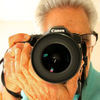Question About Step-Up Filter Ring
Jun 9, 2021 11:55:08 #
amfoto1
Loc: San Jose, Calif. USA
Brucer wrote:
Recently, I took my B + W Kaiserman 52mm circular ... (show quote)
The main problem with step-up rings (and the reason I generally won't use them) is that you cannot fit the matched lens hood.
One work-around is to get a generic screw-in hood in the same diameter as the step-ring and oversize filter (67mm in this case). That can be a little tricky to get a hood that's as effective as possible without causing any vignetting.
On the plus side, a plain round screw-in filter (not a "tulip design") can be turned with a polarizer to adjust the filter's effect. A bayonet mount filter and/or one with a tulip style design cannot be turned and essentially has to be removed temporarily to adjust the filter (unless it's a very wide lens where the filter can be turned with a finger reaching inside a shallow lens hood... or it's one of very few deeper bayonet mount hoods that have a little "door" in the side to allow access to turn the filter).
A possible disadvantage to using a metal, screw-in lens hood is that it doesn't provide as good physical protection to the lens (and filter) as a plastic, bayonet mount hood. An impact on a metal, screw-in hood will be largely transmitted to whatever it's screwed into. An impact on a plastic bayonet hood, on the other hand, might break the hood itself, but is less likely to transmit the force of the blow to the lens. (Note: I don't recommend rubber hoods for most purposes... Most of them collapse too easily and won't give the lens much physical protection. Also, rubber hoods are typically only offered in limited shapes, which may or may not be very effective shading the lens and filter. An exception is that rubber hoods can be handy when you're forced to shoot through glass, such as aquarium or an airplane window.)
On the negative side, while there are cheap ones, some screw-in lens hoods cost almost as much as a correct sized filter would costs. For example:
- 67mm B+W lens hood $40 (telephoto)
- 67mm Heliopan lens hood $48 (telephoto)
- Other brands and types of hoods $10 to $15 (normal, wide, tele).
Plus the cost of the step-up ring, which range from around $5 to $40 in the 52 to 67mm size! The cheapest brass one I could find costs $20.
For comparison:
- 52mm B+W "MRC" C-Pol $50 (standard type of circular polarizer, multi-coated)
- 52mm B+W "F-Pro" C-Po $57 (high transmissive, Kaesemann, multi-coated)
- 52mm B+W "XS-Pro" C-Pol $59 (same as F-Pro except "Nano" multi-coatings, slim mount).
Prices above are all from B&H Photo, but probably are similar elsewhere.
At one point, years ago when I was shooting film and using many filters, I used step rings a lot and eventually managed to find good fitting and reasonably effective screw-in hoods to use with them. With film I used around 25 or 30 different types of filters and the step rings allowed me to only need them in two sizes (for a total of around 45 or 50 screw-in filters, if I recall correctly... plus a kit of rectangular graduated ND filters with adapters, holders and other accessories).
But with modern digital imaging most filter effects are easily emulated either with in-camera white balance adjustments or in post-processing and far fewer filters are needed, so I no longer use step-rings in that manner. I only carry three types of filters: C-Pol in all the sizes my lenses require, UV in most sizes too in case I find myself shooting in conditions where I want some lens protection or where UV filtration might actually serve a purpose, and a few neutral density filters in a couple sizes I'm likely to use (don't need them for most telephotos, but do occasionally want them with wide to normal lenses and large aperture lenses). I no longer carry color correction, color conversion, warming, cooling filters, among others. Today C-Pol are easily my most used filters... Both ND and UV see a lot less use. Between them, I'd consider ND more important because although they are specialized, there are some things that simply can't be done without them.
However, I do still use a few step-up rings. But only to be able to stack my different size filters for storage using a "filter stack caps"... a safe, secure and reasonably compact way to carry them. I suppose if I ever needed to fit a filter to a lens and didn't have the right size, I could use the step-up ring(s) for that purpose. But that's never happened.
Jun 9, 2021 12:39:28 #
The step up ring will not cause any change in exposure. The distance between the lens and filter is ever so slight. I have one 72mm to 77mm for my CPL filter.
If you want to reply, then register here. Registration is free and your account is created instantly, so you can post right away.
